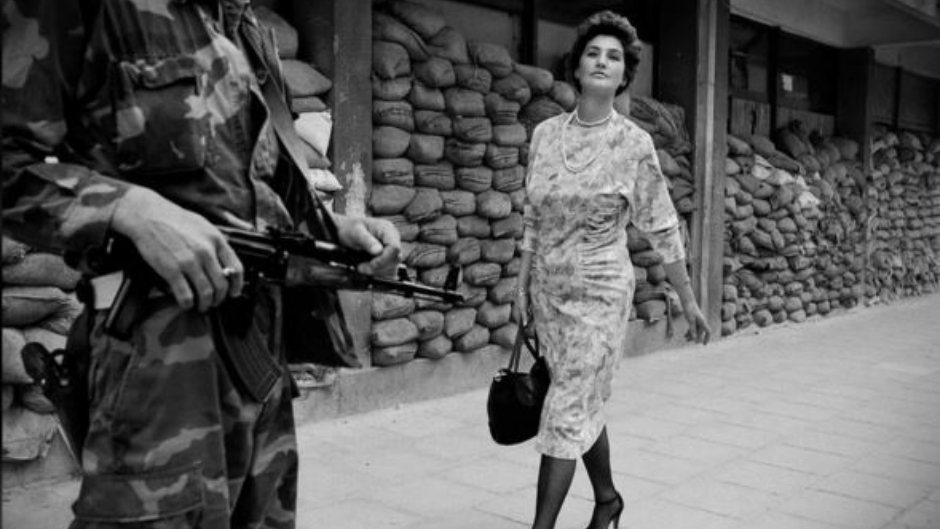
This image of Meliha Varešanović, captured by British photographer Tom Stoddart, went all around the world. It has become iconic – a classic of reportage. Yet back in 1994, while people overseas were opening their morning newspapers and talking about the beautiful women in the picture, Meliha was just thinking about how to survive another day.
“I put on one of my favorite dresses and sandals. I remember that it was the first morning with a new short haircut, because there was no water and shampoo. But I somehow straightened my hair into style. I put lipstick on, mascara and red nail polish. I walked slowly with my head held high. I never ran, especially during the war. I did not want those who saw me through snipers’ scopes to know that I was scared. I always liked to put on makeup, but at that time I wanted to do it more than ever. During the war, I wore the very best clothes I had in my wardrobe,” she says.
Sarajevo was under siege for 1,460 days. Despite the shortage of basic food items and other goods, plus the lack of electricity and water, people took a pride in their appearance – and attracted the attention of foreign journalists and women’s magazines. In the absence of other forms of power, women used clothing and beauty as a means of expression, sending a message that they were not just going to sit around waiting for the war to end. Appearance and attitude were a form of a rebellion.
Exhibitions, workshops, and roundtables have been dedicated to urban fashion culture in Sarajevo over the years, including the war period. A normal dress code was respected prior to the state of emergency – it depended upon your job or role in life – but in the nineties, these rules were abandoned. Hairdressers worked in bomb shelters, mostly free of charge. Women did not give up their fur jackets, short and long, or their hats, handbags or high-heeled shoes, even when their journey on foot to work was many kilometers long.
One of the means of obtaining clothes was through humanitarian aid or by refurbishing old pieces of clothing. During the siege, fashion designer Amna Kunovac designed ‘ready to wear’ items from fabrics that came from abroad. In times of great scarcity, such clothes were often bought by those who worked for foreign organizations, but other women also saved money to buy something beautiful for themselves.
Media reports about besieged Sarajevo were of course full of photographs and images of destruction and killings. But in 1993, a “Miss Besieged Sarajevo” beauty competition was organized – a bizarre idea but one that proved beauty could still send a strong message.
17-year-old Inela Nogić was selected as the winner, walking the catwalk while the song “Eve of Destruction” played from the loudspeakers. Along with the other contestants, she held up a banner which pleaded “Don`t let them kill us” – a photo that became a part of many subsequent reports about the besieged city.

“The aim of the competition was to show that war is more than just men and weapons and that woman also played a role in defying the goals of the killers, through raising morale and celebrating life. It was a crazy thing during the war, but we tried to live a normal life. It was some sort of a defense mechanism that we all had.” Nogić recalls.
Amateur film footage of the competition was later used by movie director Bill Carter to create the documentary “Miss Sarajevo”, which was broadcasted internationally. The footage can also be found in the video for the song “Miss Sarajevo” recorded by the U2 with the Italian opera singer Luciano Pavarotti.
Clothes inevitably carry many varied messages. The one that is visible at first glance, such as a person’s status, or belonging to a particular group in society. But there are also hidden ones that in certain circumstances serve as a response or challenge. The photographs of Meliha’s dress and Inela’s swimsuit were much more than just pieces of clothing: they were symbols of resistance.
__________________________________________________________________________________
This article was initially published within the Bosnian edition of ASBO Magazine in 2019. ASBO Magazine is an independent publication created by the D Foundation as an extension of its mission to unearth and showcase fresh talent. The magazine aims to showcase the artistic talents and potential of Bosnians and Herzegovinians in an effort to empower and give them an international platform to share their work, ideas, and opinions on music, fashion, art, and cinematography.






